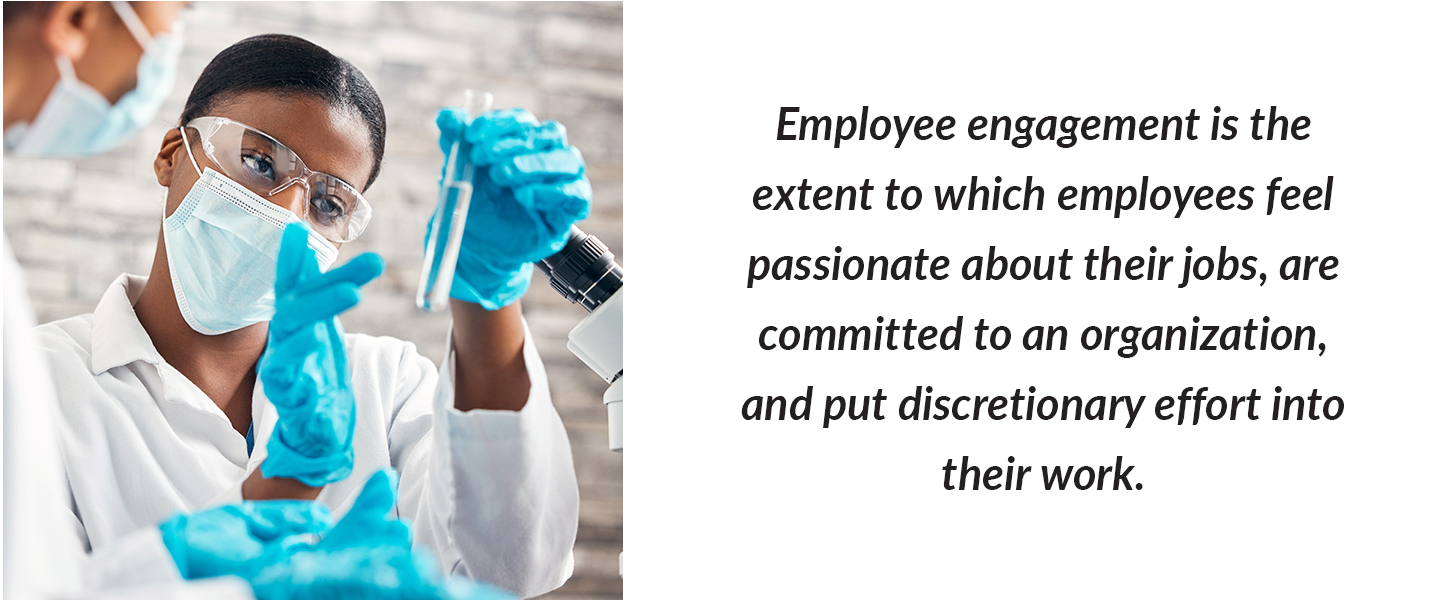In September of 2021, the research team at Press Ganey surveyed more than 1,100 people to learn about their experiences and preferences as healthcare consumers. Among other things, Press Ganey found a clear link between the employee engagement levels of healthcare workers and patient satisfaction and loyalty.
This finding is especially meaningful for managers of clinical laboratory operations. For a clinical lab to perform efficiently, employee engagement and retention must be a top leadership priority. The higher the engagement level of clinical lab employees, the more productive and profitable the lab will be.
In the blog that follows, we begin by defining the somewhat vague idea of “engagement” and why it is so important. We then explore some of the ways that clinical lab directors can maximize laboratory team performance by focusing on the engagement levels of lab employees.
What is Employee Engagement?
The concept of employee engagement can be difficult to describe. Most definitions focus on the emotional connection between employer and employee. However, the HR assessment experts at Custom Insight said it best:
Employee engagement is the extent to which employees feel passionate about their jobs, are committed to an organization, and put discretionary effort into their work.

That discretionary effort, in turn, drives greater performance throughout an organization. When measuring employee engagement, the research shows a clear link between employee engagement and business performance.
- Highly engaged employees have 70% fewer workplace safety incidents.
- Absenteeism is 41% lower at companies with highly engaged employees.
- Turnover rates are 59% lower among highly engaged workforces.
- Companies with engaged employees report 6% higher net profit margins on average.
Employee Engagement in a Clinical Lab Environment
Defining employee engagement is one thing; bringing it to life in the workplace is something entirely different. Below are three drivers of employee engagement that managers can focus on in a clinical lab setting.
1: Invest in the environment
To form an emotional connection with an employer, the employee must first feel a part of something bigger than themselves. In a healthcare setting such as a clinical lab, that translates to a work environment in which the brand and culture of the company are clearly communicated at every turn. For example:
- Signage systems that celebrate the history, mission and culture of the company.
- Gloves, gowns and other PPE products that provide a tangible, physical reminder that you care about employee safety.
- Corporate identity and branding materials that consistently portray the brand of the laboratory company.
- Branded apparel programs that ensure lab employees always know they are key players on a larger team.
2: Make their jobs easier
A key driver of employee engagement is having the tools and resources needed to do the job assigned. Nothing is more demotivating than having clearly established job expectations and then encountering barriers that prevent those expectations from being met. In a clinical lab, this means ensuring that employees always have what they need to perform at top efficiency.
- Things like labels, forms and specimen kits must always be up to date and close at hand.
- Technology systems should give employees fast, efficient access to critical lab-related information.
- Production workflows and operational processes must be tailored to the unique rhythms and requirements of laboratory work.
3: Offer incentives that matter
As documented by psychologist Abraham Maslow, human beings have an innate need for esteem and self-actualization. Employee rewards and recognition programs are one way that managers of clinical labs can help lab employees realize those needs. When designing an employee recognition program, be sure to remember these best practices.
- Employee recognition awards don’t have to be expensive. Something as simple as a handwritten note of appreciation from a manager can be have a significant impact on the employee experience and enhance engagement.
- Small and frequent rewards are more powerful than large, annualized recognition. Research by Globoforce/Workhuman revealed that employees who receive regular small rewards – whether money, points redeemable for merchandise, or simple notes of thanks – were eight times more engaged than those who simply received pay and bonus increases once per year.
- Peer-to-peer recognition is especially powerful. Empowering lab employees to recognize co-workers helps to build camaraderie, reinforces corporate culture and often carries more weight than top-down recognition.
- When selecting promotional merchandise for a recognition program, pay special attention to the utility of the items. Promo merchandise that can be used by the employee on a daily basis is more likely to hold a high perceived value. Things like branded lunch coolers, phone chargers and water bottles can provide a tangible daily reminder of the recognition received.

Taylor Healthcare: Employee Engagement Solutions for Clinical Labs
Taylor Healthcare has decades of experience with employee rewards and recognition programs like those described above. We have the ability to develop a recognition system customized for your organization, complete with an easy-to-use online ordering platform with robust controls and reporting. Our affiliation with Taylor Corporation – one of the ten largest promotional marketing distributors in North America – also gives us access to a vast assortment of branded merchandise and apparel items.
Contact a Taylor Healthcare representative to learn more.










